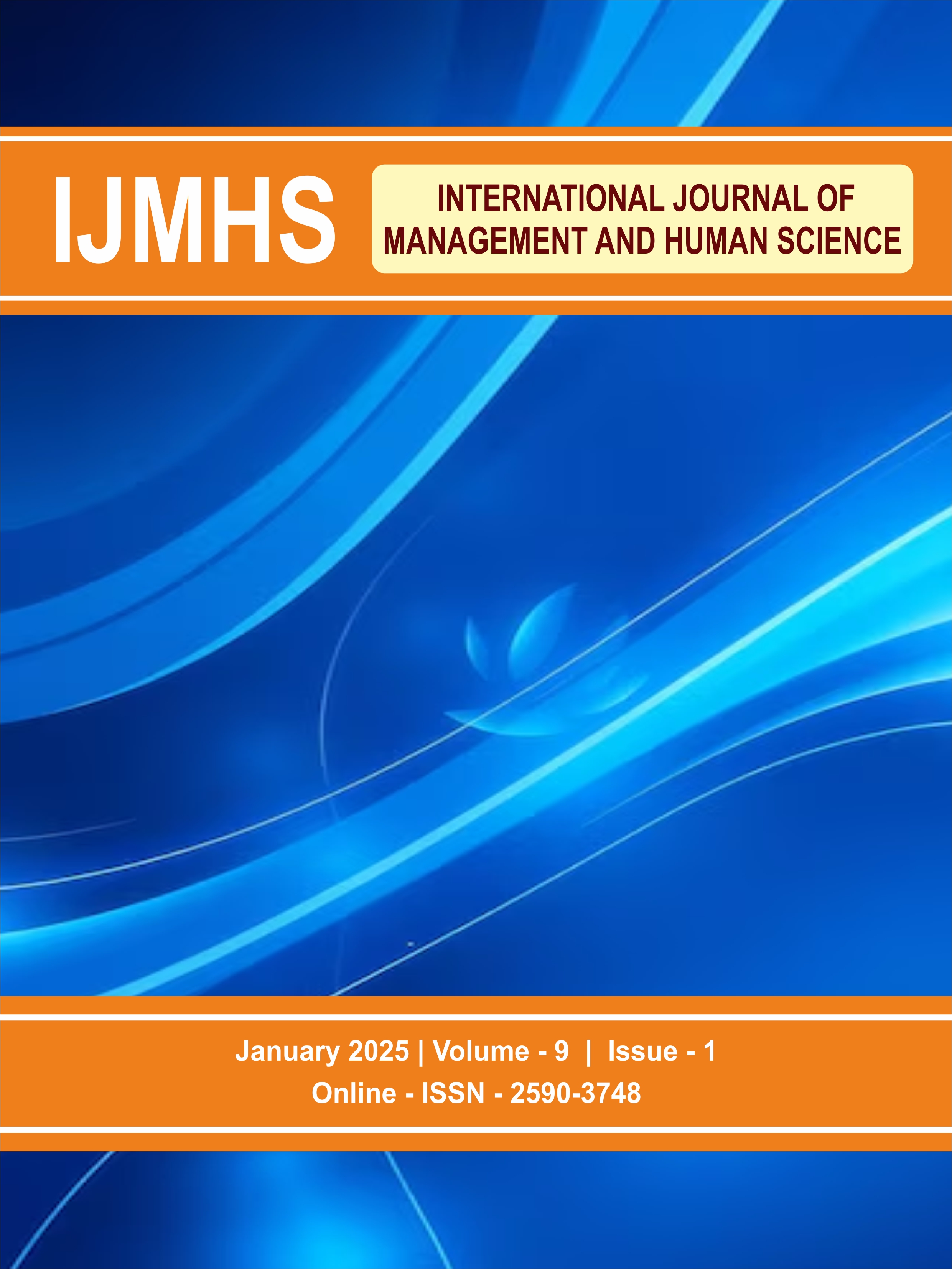Sensational Marketing for Trending Marketing Practices: Conceptualisation of Strategic Intuitional Marketing Techniques for Business Enhancement, with Special Reference to the Perfume Industry in Sri Lanka
DOI:
https://doi.org/10.31674/ijmhs.2025.v09i01.003Abstract
Marketing strategies play a fundamental role in defining consumer perceptions and business success. This study focuses on reviewing the concepts of intuitional marketing techniques to conceptualise a technique for business enhancement in Sri Lanka, the delivery of superior customer value, and the performance of intuitional decision-making. It examines how these aspects contribute to enhancing customer satisfaction. The context of the paper refers to sensory marketing in the business field, which is a significant aspect of both the local and international markets. Within the scope of the study, it analyses the conceptualised system and the approach to targeting customers. It also explores and addresses the gap between the sensational values of customers. The study has reviewed literature-based sources on intuition concepts related to marketing perspectives, which interlock with intuitional marketing techniques to build conceptual arguments. This paper suggests ways to develop sensational value in customers’ minds through marketing campaigns to bridge the satisfaction gap. The conclusion provides guidance on implementing the proposed techniques for future marketing studies and improving the effectiveness of existing sensory marketing campaigns.
Keywords:
Intuition, Marketing Practices, Perfume Industry, Sensational Values, Sensory MarketingDownloads
References
Abdolmohamad Sagha, M., Seyyedamiri, N., Foroudi, P., & Akbari, M. (2022). The one thing you need to change is emotions: The effect of multi-sensory marketing on consumer behavior. Sustainability, 14, 2334. https://doi.org/10.3390/su14042334
Arkes, H. R., & Kajdasz, J. E. (2011). Intelligence analysis: Behavioral and social scientific foundations. In Management Science Informatization and Economic Innovation Development Conference (MSIEID) (pp. 143–168). https://research.unl.edu/events/docs/Intelligence%20Analysis%20Behavioral%20and%20Social%20Scientific%20Foundations%20NRC%202011.pdf
Banar, M., Cokaygil, Z., & Ozkan, A. (2009). Life cycle assessment of solid waste management options for Eskisehir, Turkey. Waste management, 29(1), 54-62. https://doi.org/10.1016/j.wasman.2007.12.006
Betzing, J. H., Tietz, M., Brocke, J. V., & Becker, J. (2019). The impact of transparency on mobile privacy decision making. Electronic Markets, 29, 155-167. https://doi.org/10.1007/s12525-019-00332-3
Birman, D. (2005). Ethical issues in research with immigrants and refugees. The handbook of ethical research with ethnocultural populations and communities, 155-178. https://citeseerx.ist.psu.edu/document?repid=rep1&type=pdf&doi=804bba3d315e34996178f5cb301ac12aae6ec5c6
Carù, A., & Cova, B. (2003). Revisiting consumption experience: A more humble but complete view of the concept. Marketing Theory, 3(2), 267–286. https://doi.org/10.1177/14705931030032004
Chen, Z., Zhou, X., Chen, J., Yang, Y., Zhou, M., & Lin, L. (2020, December). Application of financial information and digital transformation in corporate governance: A scientometric investigation. In 2020 Management Science Informatization and Economic Innovation Development Conference (MSIEID) (pp. 277-280). IEEE. https://doi.org/10.1109/MSIEID52046.2020.00057
Dé Ishtar, Z. (2005a, September). Striving for a common language: A white feminist parallel to Indigenous ways of knowing and researching. In Women's Studies International Forum (Vol. 28, No. 5, pp. 357-368). Pergamon. https://doi.org/10.1007/978-1-4020-8567-3_11
Dé Ishtar, Z. (2005b, September). Living on the ground: The “culture woman” and the “missus”. In Women's Studies International Forum (Vol. 28, No. 5, pp. 369-380). Pergamon. https://doi.org/10.1007/978-1-4020-8567-3
Delpit, L., & Dowdy, J. K. (Eds.). (2008). The skin that we speak: Thoughts on language and culture in the classroom. The New Press. https://thenewpress.com/books/skin-that-we-speak
Dissanayake, D. R. (2015). Factors determine the customer-celebrity relationship towards perceived celebrity endorsements: Propositions to hypothesize future studies in Sri Lankan services sector. Sri Lanka Journal of Marketing (SLJM), 1(2), 1-19.
Eldridge, S., van Iwaarden, J., van der Wiele, T., & Williams, R. (2013). Management control systems for business processes in uncertain environments. International Journal of Quality & Reliability Management, 31(1), 66-81. http://dx.doi.org/10.1108/IJQRM-03-2012-0040
Epstein, S. (2010). Demystifying intuition: What it is, what it does, and how it does it. Psychological Inquiry, 21(4), 295–312. https://doi.org/10.1080/1047840X.2010.523875
Ghasemi, H., & Rasekh, N. (2019). Sensory Marketing and Brand Trust: A Case of Sports Shops Customers. Sport Management Studies, 11(53), 121-138. https://doi.org/10.22089/smrj.2018.5117.2003
Goel, P., Garg, A., Sharma, A., & Rana, N. P. (2023). Impact of Sensory Perceptions on the Urge to Buy Impulsively. Journal of Computer Information Systems, 64(4), 469-485. https://doi.org/10.1080/08874417.2023.2224748
Gowans, C. W. (2014). Buddhist moral philosophy: An introduction. Routledge. https://www.routledge.com/Buddhist-Moral-Philosophy-An-Introduction/Gowans/p/book/9780415890670?srsltid=AfmBOoow61noyhpys1wv0ndyDesv4sj0IKLflkJI36djZWs7pSAADJmR
Grönroos, C. (2008). Service logic revisited: who creates value? And who co‐creates?. European business review, 20(4), 298-314. https://doi.org/10.1108/09555340810886585
Grönroos, C. (2011). Service as business logic: implications for value creation and marketing. Journal of Service Management, 22(1), 5-22. https://doi.org/10.1108/09564231111106893
Hall, B. L., & Kulig, J. C. (2004). Kanadier Mennonites: A case study examining research challenges among religious groups. Qualitative Health Research, 14(3), 359–368. https://doi.org/10.1177/1049732303261866
Hogarth, R. M. (2010). Intuition: A challenge for psychological research on decision making. Psychological Inquiry, 21(4), 338–353. https://doi.org/10.1080/1047840X.2010.520260
Husain, R., Paul, J., & Koles, B. (2022). The role of brand experience, brand resonance, and brand trust in luxury consumption. Journal of Retailing and Consumer Services, 66(2). https://doi.org/10.1016/j.jretconser.2021.102895
Krishna, A. (2012). An integrative review of sensory marketing: Engaging the senses to affect perception, judgment and behavior. Journal of Consumer Psychology, 22(3), 332-351. https://doi.org/10.1016/j.jcps.2011.08.003
Krupka, Z. (2023). Exploring the influence of sensory marketing on brand perception. Naše gospodarstvo/Our Economy, 69(3), 45–55. https://doi.org/10.2478/ngoe-2023-0017
Kuesten, C. (2011). Sensory marketing by Bertil Hulten, Niklas Broweus, and Marcus Van Dijk. Journal of Product Innovation Management, 28. https://doi.org/10.1111/j.1540-5885.2011.00829_1.x
Liamputtong, P. (2010). Performing qualitative cross-cultural research. Cambridge University Press.
Lin, H. H., & Cheng, J. H. (2020). A study of the simulation and analysis of the flow field of natural convection for a container house. Sustainability, 12(23), 9845. https://doi.org/10.3390/su12239845
Macdonald, E. K., Wilson, H., Martinez, V., & Toosi, A. (2011). Assessing value-in-use: A conceptual framework and exploratory study. Industrial Marketing Management, 40(5), 671–682. https://doi.org/10.1016/j.indmarman.2011.05.006
Mishra, S., Ewing, M. T., & Pitt, L. F. (2020). The effects of an articulated customer value proposition (CVP) on promotional expense, brand investment and firm performance in B2B markets: A text based analysis. Industrial Marketing Management, 87, 264-275. http://dx.doi.org/10.1016/j.indmarman.2019.10.005
Moore, C. M., & Doherty, A. M. (2007). The international flagship stores of luxury fashion retailers. In Fashion Marketing (pp. 277-296). Routledge. https://www.taylorfrancis.com/chapters/edit/10.4324/9780080468174-14/international-flagship-stores-luxury-fashion-retailers-christopher-moore-anne-marie-doherty
Murwani, I. A., Rooseno, E. D., Cakramihardja, A., & Widjaja, J. V. (2023). The impact of sensory marketing: Analysis of its attributes towards online perfume users’ behavior. International Journal of Professional Business Review, 8(9), 1–34. http://dx.doi.org/10.26668/businessreview/2023.v8i9.3439
Nalliah, R. P. (2016). Clinical decision making–choosing between intuition, experience and scientific evidence. British Dental Journal, 221(12), 752-754. https://doi.org/10.1038/sj.bdj.2016.942
Papadopoulos, I., & Lees, S. (2002). Developing culturally competent researchers. Journal of Advanced Nursing, 37(3), 258-264. https://doi.org/10.1046/j.1365-2648.2002.02092.x
Paul, J. (2019). Masstige model and measure for brand management. European Management Journal, 37, 1-14. https://doi.org/10.1016/j.emj.2018.07.003
Pétervári, J., Osman, M., & Bhattacharya, J. (2016). The role of intuition in the generation and evaluation stages of creativity. Frontiers in Psychology, 7, 1420. https://doi.org/10.3389/fpsyg.2016.01420
Priyankara, R., Weerasiri, S., Dissanayaka, R., & Jinadasa, M. (2017). Celebrity endorsement and consumer buying intention with relation to the television advertisement for perfumes. Management Studies, 5(2), 128-148. https://doi.org/10.17265/2328-2185/2017.02.005
Raidl, M. H., & Lubart, T. I. (2001). An empirical study of intuition and creativity. Imagination, cognition and personality, 20(3), 217-230. https://citeseerx.ist.psu.edu/document?repid=rep1&type=pdf&doi=412997d2cd4e7b477e8e5008a6a58b1ea3785ef4
Rupini, R. V., & Nandagopal, R. (2015). A Study on the Influence of Senses and the Effectiveness of Sensory Branding. Journal of Psychiatry, 18(2), 236. https://doi.org/10.4172/1994-8220.1000236
Smilansky, S. (2017). Experiential marketing: A practical guide to interactive brand experiences. Kogan Page Publishers. https://www.iibms.org/pdf/e-library/Experiential-Marketing.pdf
Soleimani, M., Ahmadi, S., & Akbar Zohrehvand, A. (2021). The impact of sensory marketing on customer loyalty in private sports clubs: Using perceived value as the mediating variable. Revista Euroamericana de Ciencias del Deporte, 10(1), 119-124. https://digitum.um.es/digitum/bitstream/10201/101188/1/The%20impact.pdf
Spinuzzi, C., Altounian, D., Pogue, G., Cochran, R., & Zhu, L. (2018). Articulating problems and markets: A translation analysis of entrepreneurs’ emergent value propositions. Written Communication, 35(4), 379-410. https://doi.org/10.1177/0741088318786235
Walumbwa, F. O., Maidique, M. A., & Atamanik, C. (2014). Decision-making in a crisis: What every leader needs to know. Organizational Dynamics, 43(4), 284-293. http://dx.doi.org/10.1016/j.orgdyn.2014.09.005
Wasantha, H. N., Ali Sekak, M., & Ghosh, A. (2015). Municipality development for business growth: Conceptualization of strategic delivery model for Sri Lanka.
Wasantha, H. N., Gunawardane, S. K. (2021). Impact of Personality Traits on Purchasing Behavior Towards Personal Care Products Special Reference Youth in Selangor. Global Scientific Journal, 8(10), 1468-1489.
Zha, D., Foroudi, P., Melewar, T. C., & Jin, Z. (2024). Examining the impact of sensory brand experience on brand loyalty. Corporate Reputation Review, 28(1), 1-29. http://dx.doi.org/10.1057/s41299-023-00175-x
Published
How to Cite
Issue
Section
License
Copyright (c) 2024 International Journal of Management and Human Science (IJMHS)

This work is licensed under a Creative Commons Attribution-NonCommercial-NoDerivatives 4.0 International License.
















